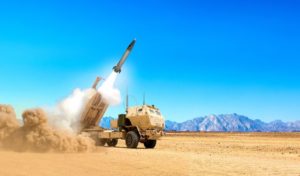A new Army paper released Tuesday offers insight into the Army’s plans to transform into a force prepared for large-scale, multi-domain combat operations by 2035, specifically highlighting long-range strike and advanced command and control capabilities to best support future joint force operations.
The document offers key priorities expected to be included in the Army’s forthcoming release of its new Multi-Domain Operations doctrine in the summer of 2022, and how the service plans to support its component of the future Joint All Domain Operations concept.

“Although our Army still maintains overmatch, it is fleeting. In the face of determined adversaries and accelerating technological advances, we must transform today to meet tomorrow’s challenges,” Gen. James McConville, the Army chief of staff, writes in the introduction to the new paper, “We must therefore continue to implement a 21st century talent management system, develop and field new weapon systems, transform our doctrine, build new organizations, and change the way we train. This bold transformation will provide the Joint Force with the range, speed, and convergence of cutting edge technologies that will be needed to provide future decision dominance and overmatch required to win the next fight.”
The next decade-and-a-half push to build an MDO-capable force will require continued modernization to field advanced capabilities, according to the document, to meet peer competitors’ China and Russia push to develop their own asymmetric capabilities by 2040.
“The capability to strike in depth with lethal and non-lethal cross-domain effects is critical to creating overmatch in operations against a peer adversary,” the Army writes. “Army multi-domain forces will be organized and equipped to extend land-based effects into other domains, providing a suite of tools to integrate in the joint fires process, from the onset.”
These long-range fires could include “short, mid, and long range precision fires to engage and destroy adversary land, air, and sea capabilities in depth,” with the Army currently working on programs from hypersonic weapon development, a new mid-range missile effort and the future Precision Strike Missile program.
McConville said recently the service’s investments in a suite of new long-range precision fires can play a critical role supporting future operations in the Indo-Pacific, specifically the ability to penetrate adversaries’ Anti-Access/Area Denial (A2/AD) capabilities to open up more options for the Air Force and Navy (Defense Daily, March 12).
The paper also highlights the requirement for advanced unmanned systems and machine learning-enabled ISR capabilities to enable “deep operations” with “surprise, simultaneity, and speed.”
“To strike targets of the highest operational value, those that are able to or preparing to launch offensive attacks against our forces, deep operations must maximize flexibility,” the Army writes.
Building on the ongoing Project Convergence effort to build a new ‘sensor-to-shooter network’ with its future capabilities able to pass targeting data in a matter of seconds, the Army says it will in the future leverage advanced data and AI capabilities to enable joint “decision dominance.”
“The requirement for decision dominance drives the Army’s programs in support of Combined Joint All-Domain Command and Control focused on system data standardization, cloud migration and software-based experimentation with the joint community,” the Army writes. “The use of artificial intelligence and machine learning informed computing will unburden commanders and staffs from performing time-intensive cognitive functions, and focus their efforts on accelerated, optimized decision-making.”
In 2028, the Army plans to reassess its assumptions on requirements for future multi-domain operations and then adjust investments as needed, according to the document.